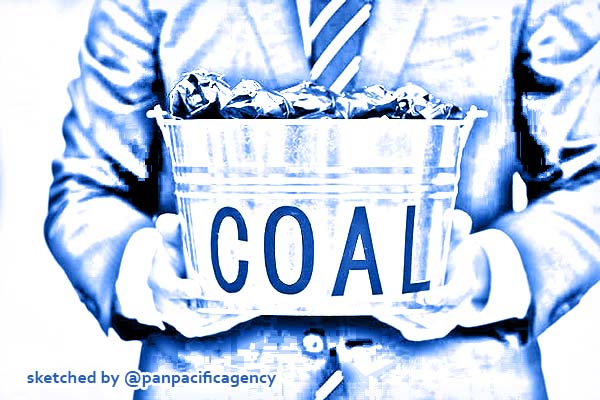[Analytics] Will Japan continue to finance international coal projects?

A protester holds a bucket of coal during a demonstration demanding that Japan stop supporting coal at home and overseas, at the G20 Summit in Osaka on June 28. Photo: REUTERS/Jorge Silva. Sketched by the Pan Pacific Agency.
Japan’s support for international coal projects has been the subject of unrelenting criticism. The release of a new Infrastructure System Export Strategy suggests that its position may be shifting as some in government question Japan’s enduring embrace around coal. After China, Japan is the world’s largest public funder of international coal projects. Christian Downie, Llewelyn Hughes specially the East Asia Forum.
Between 2010 and 2019, Japanese public lending bodies lent funds, or insured lending, in support of 21 thermal coal power generation projects in Bangladesh, India, Indonesia, Mongolia, Myanmar and Vietnam, with a combined total of 24,138 megawatts of capacity. Of the various public lending bodies, the Japan Bank for International Cooperation (JBIC) was the largest lender, loaning more than US$12 billion to overseas coal projects between 1994 and 2014.
There are several reasons why Japan’s backing of coal is a problem. The first and most obvious is that it is incompatible with global efforts to address climate change under the 2015 Paris Agreement. Addressing climate change requires a dramatic reduction in greenhouse gas emissions, a substantial share of which must come from the power sector. But because of thermal coal plants being backed by China, Japan and South Korea, the power sector continues to be one the of largest contributors to rising emissions.
Second, locking countries into coal raises financial risks. Many of the thermal coal plants that Japanese taxpayers are financing in developing countries plan to operate for decades. Yet there is a real risk of these assets becoming stranded in response to more stringent climate policies globally. This poses significant debt risks to recipient countries in particular, depending on how the loans are structured.
The potential value of stranded assets is large. Among G20 countries, the value of stranded assets in the power sector between 2015 and 2050 created by the turnover of fossil fuel power generation capital stock is estimated at US$927 billion. Thermal coal-related assets represent approximately 75 per cent of the total estimated value. The International Energy Agency calculates that 290 gigawatts of subcritical coal generation will need to be shut globally by 2020 to keep global emissions in line with the Paris Agreement’s two degree Celsius warming scenario.
Japanese support for international coal plants has long been part of its export strategy. The Japanese government provides funding to developing countries for new coal-fired power plants, and large Japanese conglomerates, such as Mitsubishi, Hitachi and Toshiba, provide their coal technology to build plants. This strategy may be unravelling. This year’s Infrastructure System Export Strategy will permit Japan to continue funding coal plants abroad, but its funding may be more narrowly targeted to support more advanced technology, such as ultra-supercritical coal technology.
As some environmental groups point out, there are major loopholes in the strategy, including that it does not apply to projects already in the planning stage. The joint statement from these environmental groups claims that three projects, one each in Vietnam, Indonesia and Bangladesh, are likely to fall into this category.
Nevertheless, this is a promising sign of a potential crack in the Japanese government’s support for coal. Japan’s high profile environment minister Shinjiro Koizumi pointed out that Japan is starting to pay attention to the global criticism it receives over coal. His ministry sought to review the conditions associated with export finance for coal-fired power plants in February.
And it is not just the climate problem that is getting attention. As part of the review process, the Ministry of Environment identified the emergence of stranded assets as a risk that should be managed through public investment choices. In other words, there is now a financial downside to backing international coal plants and Japan is conscious of managing this risk.
Any likelihood that Japan is about to walk away from international coal projects altogether should be tempered by the fact that multiple organisations are involved in the decisions surrounding, and implementation of, the strategy. This includes the Ministry of Economy, Trade and Industry, which has been an strong supporter of coal.
But if the outcome of the Infrastructure System Export Strategy is anything to go by, it too may be paying attention to the global criticism. JBIC President Tadashi Maeda, recently reiterated his view in the media that the bank would not lend to any new coal generation projects going forward. In this context, it will be important to watch how these signalled changes in strategy translate into project rules on the ground.
Still the cracks in coal’s support base are not just in government. A string of Japanese companies and private banks have announced that they are withdrawing, or intend to withdraw, from thermal coal technology exports, including such large banks as Sumitomo Mitsui Financial Group and Mizuho Financial Group. They have come under sustained pressure from environmental groups and investors to change lending practices. With the global coal industry in decline, it is now a question of when, not if, nations like Japan end their historical support for coal.
Christian Downie is a Fellow in the School of Regulation and Global Governance, The Australian National University. Llewelyn Hughes is Associate Professor at the Crawford School of Public Policy, The Australian National University.